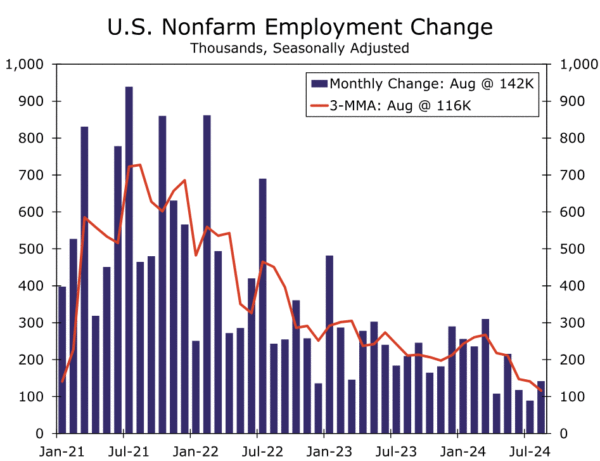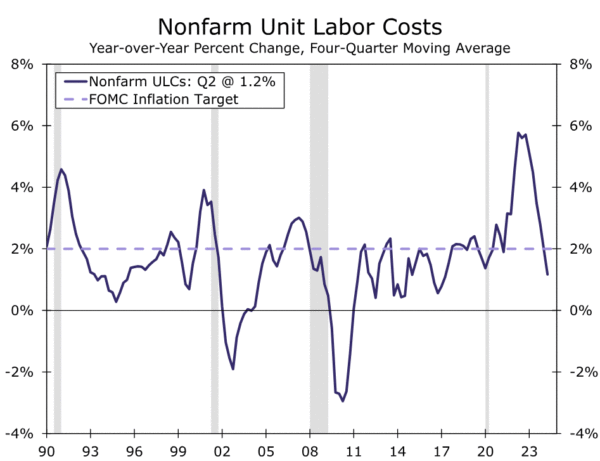Summary
The August employment report indicated that while the jobs market is not unraveling, it continues to clearly weaken. Employers added 142K jobs in August, which was a bit less than expected, but came on the heels of another significant downward revision to prior months’ hiring. Over the past three months, employers have added 116K jobs, a notable deceleration from the 207K average pace in the first half of the year. The breadth of hiring improved slightly over the month but continues to be concentrated in less-cyclically sensitive industries.
The unemployment rate ticked down to 4.2% in August from 4.3%, offering some comfort that labor market conditions are not deteriorating in a non-linear way. However, joblessness has continued to rise on trend, with the Sahm Rule indicator, at 0.57, still above the threshold historically associated with recession. The rise in the broader U-6 measure of unemployment, which also captures under-employment, to a new cycle high demonstrates further signs of softening beyond the Employment Situation report’s marquee nonfarm payroll numbers.
An especially strong or weak employment report could have crystallized the 25 or 50 bps rate cut debate for the FOMC’s upcoming meeting. Instead, today’s data have offered something for both the hawks and the doves on the Committee.
We have been projecting a 50 bps rate cut at the September FOMC meeting for the past month, and for now we are leaving that forecast unchanged. That said, neither outcome would surprise us at this point, and we will be listening to the remaining remarks from Fed officials before the black out period and waiting for Wednesday’s CPI report for final clues. Regardless of what shakes out in September, we are confident that a series of rate cuts are coming in the months ahead. Any additional labor market cooling would be unwelcome for the FOMC, and as a result shifting the stance of monetary policy from restrictive to neutral over the next year or so remains our base case.
Labor Market Still Cooling, but Expansion Remains Intact
Nonfarm payrolls grew by 142K in August, a bit weaker than the Bloomberg consensus forecast that was looking for a 165K gain and our expectation for a 145K increase. Downward revisions to job growth in the prior two months pushed the three-month moving average for nonfarm payroll growth down to 116K. This marks a notable deceleration from the average monthly job growth of 207K in the first half of the year and 251K in 2023. Furthermore, the hefty 818K downward revision to the level of employment in March implied by the preliminary annual benchmark revision suggests the current pace of hiring could be even lower if the Bureau of Labor Statistics’ methodology is continuing to overstate the boost to payrolls generated by new firms.
Job growth in August was a bit more broad-based than it was in July. The labor market diffusion index, a measure of the breadth of hiring across industries where higher numbers imply more broad-based hiring, rose to 53.2 from 47.8 in July, but this remains a fairly narrow hiring base relative to earlier in this expansion and the 2010s cycle (chart). Employment growth continues to be led by hiring in less cyclically-sensitive industries such as health care & social assistance (+44K), leisure and hospitality (+46K) and government (+24K). Construction employment also posted a strong 34K increase in the month, but elsewhere hiring was tepid with just a 8K increase for profession and business services and contractions in manufacturing (-24K), retail trade (-11K) and information (-7K).
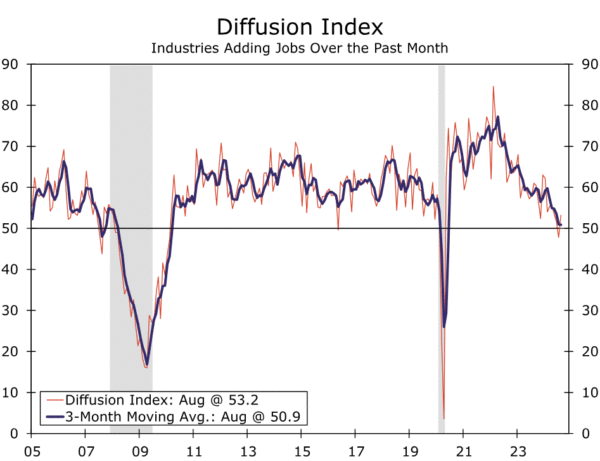 The unemployment rate offered further signs of the jobs market continuing to weaken on trend, even if it is not falling apart. As expected, the jobless rate ticked down from 4.3% in July to 4.2% as a jump in unemployment due to temporary layoffs largely, albeit not entirely, reversed. However, even with the downtick, the unemployment rate is still up from 3.8% a year ago. In a similar vein, the Sahm Rule recession indicator, at 0.57, is still above the historical threshold associated with a recession (chart). Under-employment continues to move up as well, with the broader U-6 unemployment measure, which includes people who are working part-time but would like full time work, rising to a new cycle high of 7.9% (chart).
The unemployment rate offered further signs of the jobs market continuing to weaken on trend, even if it is not falling apart. As expected, the jobless rate ticked down from 4.3% in July to 4.2% as a jump in unemployment due to temporary layoffs largely, albeit not entirely, reversed. However, even with the downtick, the unemployment rate is still up from 3.8% a year ago. In a similar vein, the Sahm Rule recession indicator, at 0.57, is still above the historical threshold associated with a recession (chart). Under-employment continues to move up as well, with the broader U-6 unemployment measure, which includes people who are working part-time but would like full time work, rising to a new cycle high of 7.9% (chart).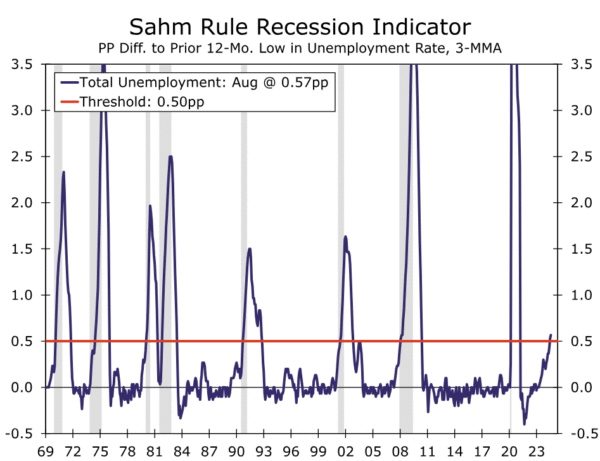
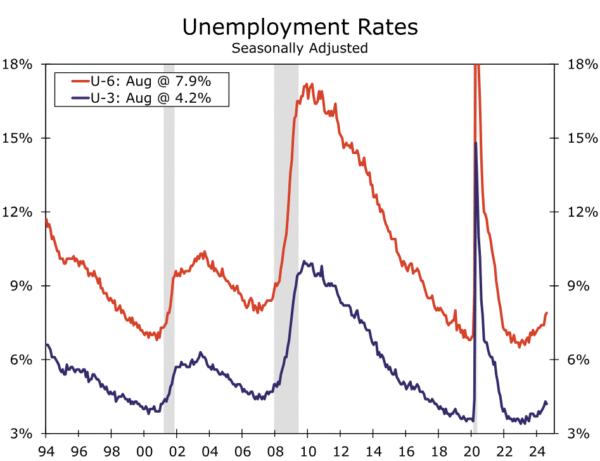
Average hourly earnings grew a touch more than expected in August, up 0.4% over the month and 3.8% over the past year. Yet despite the uptick, we believe concerns about labor costs keeping inflation uncomfortably high can be put aside for now. The overall loosening in the labor market suggests wage pressures continue to abate, while the somewhat firmer trend in productivity growth this cycle (1.6% since 2019) suggests nominal wage growth does not need to slow much further to be consistent with 2% inflation. Separately released data this week showed the four-quarter average of unit labor costs, which can be thought of as the productivity-adjusted cost of labor, up just 1.2% over the past year (chart).
In our view, today’s jobs report further reinforces that the start of the Fed’s easing cycle is upon us, and a reduction in the federal funds rate is coming at the September 17-18 FOMC meeting in less than two weeks. The much more difficult question is whether the Committee will agree to a 25 or 50 bps rate cut. This morning’s employment data offer something for both the hawks and the doves on the Committee. The tepid pace of nonfarm payroll growth, still-triggered Sahm Rule and a slew of other labor market indicators suggest that the labor market has cooled considerably in recent months. With the federal funds rate well-above most estimates of neutral, the case for moving expeditiously to a more neutral policy stance is not hard to make in our view.
That said, the July employment report sparked fears that the labor market was deteriorating in a non-linear way, and those fears seem to have been mitigated for the time being. Initial jobless claims have edged down in recent weeks, the unemployment rate partially reversed its July-increase, and nonfarm payroll growth remains comfortably in positive territory despite its slower pace. Furthermore, inflation is not all the way back to the central bank’s 2% target on a year-over-year basis, and the inflation scars from the past few years will not be quickly forgotten by some members of the FOMC.
We have been projecting a 50 bps rate cut at the September FOMC meeting for the past month, and for now we are leaving that forecast unchanged. That said, neither outcome would surprise us at this point, and based on what we know now it feels like a true coin flip between 25 and 50 bps. As we go to print, financial markets are also assigning toss-up probabilities between the two outcomes. Governor Waller is scheduled to speak on the economic outlook at 11am EST today, and we will be watching his comments closely given his history as a bellwether among the Committee. Another important factor likely will be next week’s CPI report, to be released on Wednesday, September 11. Our CPI preview report can be found here.
Regardless of what shakes out in September, we are confident that a series of rate cuts are coming in the months ahead. Any additional labor market cooling would be unwelcome for the FOMC, and as a result shifting the stance of monetary policy from restrictive to neutral over the next year or so remains our base case.




